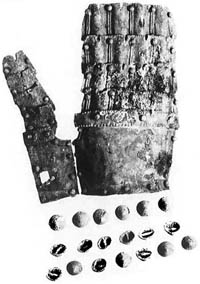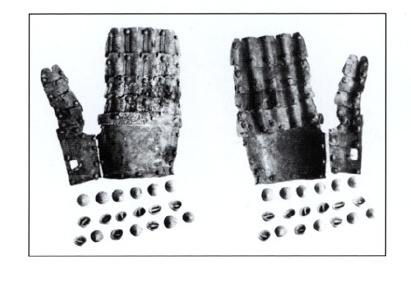Greetings, members of myArmoury! I'm new here, though I've "lurked" for a while, and I did a search to see if there was any information about this here already, but I couldn't find anything, so my apologies if this has been discussed.
I was wondering when gauntlets and mail mittens were introduced and where. I've heard the Sassanids had gauntlets for some of their cataphracts, but otherwise I couldn't find anything on pre-medieval hand protection. And I think that mail gauntlets appeared in western Europe sometime in the 13th century or so, but didn't the technology to do so exist well before that? It seems to me that hand protection was rare to nonexistent before this.
I'm inexperienced here and fairly ignorant about these sorts of things compared to the members of myArmoury, so any help is appreciated! :)
Mail mittens (mufflers) attached to the hauberk sleeve appear in the last quarter of the 12th century. Fingered mail gloves, still attached to the hauberk, show up in the early 13th. Separate mail gauntlets start showing up around 1300.
I'll leave it to others who are more knowledgable about Roman practices to discuss their usage.
I'll leave it to others who are more knowledgable about Roman practices to discuss their usage.
I'm not aware of any hand protection before the middle ages. A lot of the myths about hand protection are caused by dodgy translations. In many cases the original authors make no distinction between various types of armour so the translator has to decide how best to translate an ambiguous term and in many cases those translators don't have the faintest clue about historical armour.
A good example is Xenophon. He speculates on a piece of armour to better protect cavalrymen. In the passage he uses the word cheir to describe the armour, which literally means "hand", but when you read his description it is clear that the armour is intended to cover the arm, not the hand. A sloppy translator would use the word "gauntlet" to translate cheir but it would give the wrong connotation when used in that context.
A good example is Xenophon. He speculates on a piece of armour to better protect cavalrymen. In the passage he uses the word cheir to describe the armour, which literally means "hand", but when you read his description it is clear that the armour is intended to cover the arm, not the hand. A sloppy translator would use the word "gauntlet" to translate cheir but it would give the wrong connotation when used in that context.
This looks interesting, scroll down halfway to
3. Armoured gauntlets from Langobardic cemetary http://members.ozemail.com.au/~chrisandpeter/...fences.htm
3. Armoured gauntlets from Langobardic cemetary http://members.ozemail.com.au/~chrisandpeter/...fences.htm
Apparently some Roman manica had partial hand protection, just the wrist and part of the back of the hand. http://www.romanarmy.net/manica.htm In Mycenae chamber tomb 15 was found a bronze object that some have interpreted as a sort of gauntlet, though it is more likely ankle protection as those are described by Homer while gauntlets never are. http://www.salimbeti.com/micenei/armour4.htm Some Sardinian statuettes from the same general timeframe seem to show a sort of vambrace with protection for the back of the hand, but the evidence is far from conclusive. In general, hand protection was considered superfluous by cultures that relied primarily on the shield for protection. While early gauntlets do overlap the period of heavy reliance on the shield, they do not really come into their own until the transition to the use of polearms and longswords rather than shields. Even during the transitional period, there was an increased reliance on the sword for defence, thus the developement of longer crosses. I do a lot of Viking Age reenacting and ever since I learned to use my shield properly I have never once taken a hit to my hand or lower forearm. Oakeshott shows some art work in "Archaeology of Weapons" from Migration Era Balkans that seems to show a sort of splint gauntlet which he compares to the Vendel Era splint vambrace.
Edit: The very one which Len pointed out above. According to that page, the Vendel vambrace was made to have a mail gauntlet attached, something I was previously unaware of.
Edit: The very one which Len pointed out above. According to that page, the Vendel vambrace was made to have a mail gauntlet attached, something I was previously unaware of.
Last edited by Scott Woodruff on Thu 08 Nov, 2012 7:30 pm; edited 1 time in total
| Scott Woodruff wrote: |
| In Mycenae chamber tomb 15 was found a bronze object that some have interpreted as a sort of gauntlet, though it is more likely ankle protection |
It doesn't look like hand or ankle armour to me. I haven't a clue what it is.
| Quote: |
| as those are described by Homer while gauntlets never are. http://www.salimbeti.com/micenei/armour4.htm |
There is no ankle armour in the Iliad. Salimbeti isn't translating the passage properly. In my book there is an appendix that extracts and translates all of the armour references in the Iliad.
Please expand. What do the original passages describe? I have always taken that object from Mycenae with a grain of salt, even when I thought anklets were a piece of real Homeric armour, I always thought that that object would be most uncomfortable to wear. Perhaps it was some sort of torture device ;)
Edit: Duh, I have your book, I'll go check out the appendix now.
Edit: Duh, I have your book, I'll go check out the appendix now.
Wow, these are great responses!
The Lombard mail is interesting, but the source doesn't really give proof that the mail was used to protect the hands, just that it seemed to. Of course, I haven't actually seen pictures of the finds.
The Lombard mail is interesting, but the source doesn't really give proof that the mail was used to protect the hands, just that it seemed to. Of course, I haven't actually seen pictures of the finds.
| Scott Woodruff wrote: |
| Please expand. What do the original passages describe? I have always taken that object from Mycenae with a grain of salt, even when I thought anklets were a piece of real Homeric armour, I always thought that that object would be most uncomfortable to wear. Perhaps it was some sort of torture device ;)
Edit: Duh, I have your book, I'll go check out the appendix now. |
p. 129.
κνημῖδας μὲν πρῶτα περὶ κνήμῃσιν ἔθηκε
καλάς, ἀργυρέοισιν ἐπισφυρίοις ἀραρυίας
This is Lattimore's translation and I agree with it.
First he placed around his shins fine greaves with silver fastenings to hold them at the ankles.
Here is Butler's translation
First he greaved his legs with greaves of good make and fitted with ankle-clasps of silver.
Iliad, 3.330-1; 11.17-8, 16.132-3; 19.369-70
Thank you, that makes sense.
I wonder if any of the more recent ethnographic armour ( such as the wooden slat armour from Kamchatka) included any hand protection. Probably not, but I am going to check it out and see what I come up with. Some of the steppe cultures had pretty all-encompassing armour, so that may be another area in which to look for evidence of gauntlets.
Edit: Apparently the Siberian and Alaskan armour did not include gauntlets, though those heavy mittens might give some protection. I wonder how one shoots a bow with such a heavy mitten on. http://en.wikipedia.org/wiki/Russian_conquest_of_Siberia
I wonder if any of the more recent ethnographic armour ( such as the wooden slat armour from Kamchatka) included any hand protection. Probably not, but I am going to check it out and see what I come up with. Some of the steppe cultures had pretty all-encompassing armour, so that may be another area in which to look for evidence of gauntlets.
Edit: Apparently the Siberian and Alaskan armour did not include gauntlets, though those heavy mittens might give some protection. I wonder how one shoots a bow with such a heavy mitten on. http://en.wikipedia.org/wiki/Russian_conquest_of_Siberia
I have this image of a gauntlet, that memory tells me is ancient but that I have lost the supporting information for. I googled the image name sometimes that finds the image this time nothing.
added:
The this thread http://www.swordforum.com/forums/showthread.p...nz-Germany and the name of the image may indicate that this image is of a Sassanid gauntlet in the Römisch Germanisches Museum in Mainz, Germany
another possible thread: http://ancient-warfare.org/rat/25-allies-a-en...azpan.html
which lead here: http://schnucks0.free.fr/forum/viewtopic.php?...5:1gwk1dka
http://img515.imageshack.us/img515/2166/gante...8tknc9.jpg
pretty sure these are 6th - 7th C Sassanid gauntlets from Iran
They look pretty practical to me.
 Attachment: 33.75 KB
Attachment: 33.75 KB

Roman?
image name:
romisch_germanisches_gauntletsm_480.jpg
 Attachment: 38.28 KB
Attachment: 38.28 KB

added:
The this thread http://www.swordforum.com/forums/showthread.p...nz-Germany and the name of the image may indicate that this image is of a Sassanid gauntlet in the Römisch Germanisches Museum in Mainz, Germany
another possible thread: http://ancient-warfare.org/rat/25-allies-a-en...azpan.html
which lead here: http://schnucks0.free.fr/forum/viewtopic.php?...5:1gwk1dka
http://img515.imageshack.us/img515/2166/gante...8tknc9.jpg
pretty sure these are 6th - 7th C Sassanid gauntlets from Iran
They look pretty practical to me.

Roman?
image name:
romisch_germanisches_gauntletsm_480.jpg

Would people classify 7th C Persian armour as "Roman"?
Well there is the sassanid gauntlet shown in this thread.
Vegard Vike has written in his research that the mail fragments connected to the splints found from Valsgärde might be whats left from gauntlets.
"From Valsgärde 8 it might be possible to interpret the ring
weave-fragments fastened to two iron splinter greaves and one vambrace as
mail-mittens and foot coverings. The find was earlier misinterpreted as a torso
armour by Greta Arwidsson (1939, 1954)."
However as i have only seen a few very bad pictures about the splints i cannot really say much about it, and thus dont have a real opinion about wheater it was a gauntlet or not. Anyway, it might be possible that whoever it was, who was buried in the Valsgarde tomb wanted to have full body protection.
On the pictures before the 12 century hands tend to be unprotected, so we can say that even if some peaople used gauntlets, it was uncommon enough so the artists of the time didnt paint any.
Vegard Vike has written in his research that the mail fragments connected to the splints found from Valsgärde might be whats left from gauntlets.
"From Valsgärde 8 it might be possible to interpret the ring
weave-fragments fastened to two iron splinter greaves and one vambrace as
mail-mittens and foot coverings. The find was earlier misinterpreted as a torso
armour by Greta Arwidsson (1939, 1954)."
However as i have only seen a few very bad pictures about the splints i cannot really say much about it, and thus dont have a real opinion about wheater it was a gauntlet or not. Anyway, it might be possible that whoever it was, who was buried in the Valsgarde tomb wanted to have full body protection.
On the pictures before the 12 century hands tend to be unprotected, so we can say that even if some peaople used gauntlets, it was uncommon enough so the artists of the time didnt paint any.
I would trust Vegard's work. If he thinks that they are gauntlets then they probably are.
Page 1 of 1
You cannot post new topics in this forumYou cannot reply to topics in this forum
You cannot edit your posts in this forum
You cannot delete your posts in this forum
You cannot vote in polls in this forum
You cannot attach files in this forum
You can download files in this forum
All contents © Copyright 2003-2006 myArmoury.com — All rights reserved
Discussion forums powered by phpBB © The phpBB Group
Switch to the Full-featured Version of the forum
Discussion forums powered by phpBB © The phpBB Group
Switch to the Full-featured Version of the forum